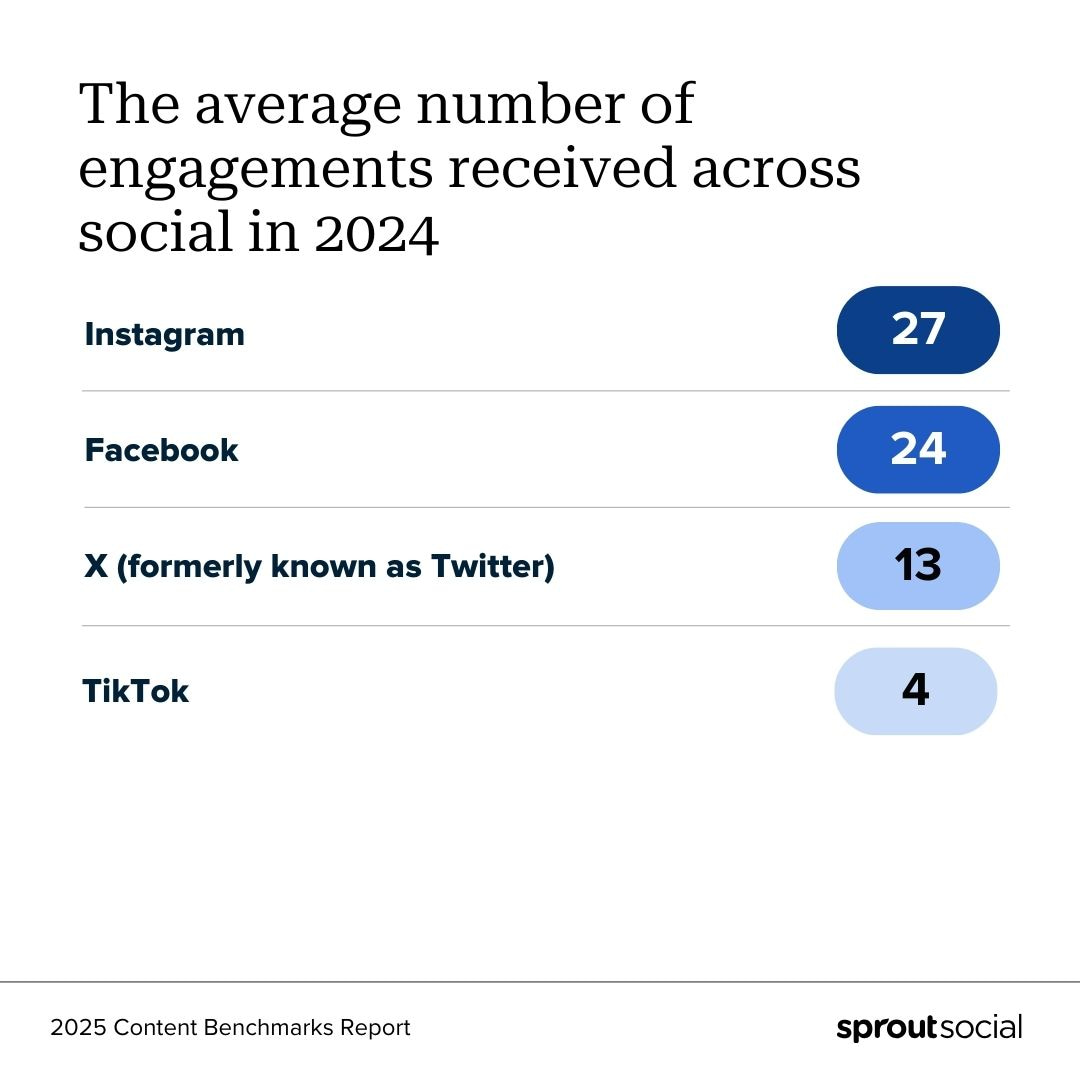Social media benchmarks by industry in 2025

Table of Contents
Sharing your performance data without including industry-specific social media benchmarks is like putting on a play without setting the stage. Sure, people will get what you’re saying, but they’ll probably come to their own conclusions about the bigger picture.
Industry benchmarks provide the context needed to tell a richer story about your social media marketing strategy.
Use data from Sprout’s 2025 Content Benchmarks Report to uncover opportunities to fine-tune your strategy in a way that resonates with your target audience. Before diving into the data, keep reading to learn more about the metrics, why they matter and how to use them to make 2025 your best year yet.
What is a social media benchmark?
A social media benchmark is a performance standard that allows social media teams to assess and compare the effectiveness of various strategies and campaigns. Marketers often use benchmark data to create realistic social media goals.
Teams can compare their results against three different types of social media benchmarks: industry benchmarks, competitive benchmarks and personal benchmarks.
What to measure in 2025: Social media benchmarks by industry
The Content Benchmarks Report analyzed more than 3 billion messages from over 1 million public social profiles that were active between February 1, 2024 and January 31, 2025. It also pulled insights from consumer surveys across the US, UK and Australia. The goal? To uncover industry benchmarks on three specific areas: posts published, inbound engagements and outbound engagements.
Here’s a detailed breakdown of each metric, along with benchmark data from the three most active industries for each metric. Download the report for a full look at the data.
Download The 2025 Content Benchmarks Report
Posts published
Posts published is a straightforward metric that measures the number of posts published across accounts during a specific period. Although it may seem simple, it’s often at the foundation of a successful social media strategy.
Narrowing in on posts published helps you reverse engineer the publishing volume needed to reach certain impressions, engagements and engagement rates. With data informing your social media goals, figuring out how to reach them is just a matter of reviewing your previous performance reports.

Brands published an average of 9.5 social posts per day across networks in 2024—a slight dip from 2023. It’s a sign that brands can pull back on volume and focus more on creating higher-quality content.
That said, not every industry is slowing down. Consumer-facing industries, in particular, continue to post at much higher rates. These include:
- Media (64 posts published per day, up from 43)
- Leisure, sports and recreation (31 published posts per day, up from 26)
- Food and beverage (8 published posts per day, up from 7)
To be fair, these industries have an edge over the rest. It’s much easier for a consumer-facing brand to align its content to trends, events or even cultural moments. Just look at how performance apparel brand Hoka hopped on the Severance-inspired “innie vs. outie” trend on TikTok.

This strategy still works, even if you’re not in the B2C space. Next time your business has something fun on the calendar, leverage your social media calendar to look at the event through a social-first lens to get more mileage out of your presence.
Inbound engagements
In this report, you’ll find two different inbound social media engagement benchmarks: average inbound engagements on content per day and average daily inbound engagements per post.
Breaking these numbers down by day and post helps validate the success of your overall strategy and individual posts. This granularity is key to measuring the success of big swings in your social creative and copy.
In 2024, brands saw a 20% jump in average inbound engagements, climbing from 70% in 2023 to 83%. Average daily inbound engagements per post also grew by 17%, rising from 12 to 14.
Of course, the more you post, the more chances your audience gets to engage. For that reason, industries that consistently surpass publishing benchmarks also receive a higher amount of inbound engagements.
Industries that receive a proportionally higher amount of inbound engagements per post compared to their publishing cadence include:
- Computer Hardware (34)
- Consumer Product Manufacturing (33)
- Banks (27)
Outbound engagements
In 2025, outbound engagements will make or break your social strategy.
People are flocking to closed communities for a more tailored online experience. To remain competitive in this new social media landscape, brands will have to double down on proactive marketing. Building 1:1 relationships on social isn’t a trick for overnight growth, but it is a controllable and sustainable path toward long-term rewards.
This marks a sizable shift in traditional brand social strategies. In 2024, the average number of outbound engagements across all industries held steady at just 2 per day. This shows that outbound efforts are still a huge growth opportunity for brands looking to build stronger two-way relationships with their audiences.
Some industries, however, are already leading the way when it comes to proactive engagement:
- Telecommunications (21 outbound engagements per day)
- Banks (21 outbound engagements per day)
- Leisure, sports & recreation and Transportation (14 outbound engagements per day)
Financial services companies like MasterCard use outbound engagements to support their brand awareness efforts. For example, the brand recently collaborated with Web3 brand 9dcc on a golf-themed capsule collection and responded to X users who shared snaps of the gear.

Social media engagement benchmarks across social networks
One-size-fits-all social media strategies are a thing of the past. Between ongoing network fragmentation and the rise of new content formats, teams must create bespoke strategies that account for the nuances of each platform.
Every social media network has its trends and communication norms, which impact how consumers interact with brands in those spaces. Segmenting your social media benchmark data by network is a powerful way to ensure that expectations align with user preferences.

According to the 2025 Content Benchmarks Report, Meta platforms continue to lead the way in terms of activity. Engagements on Facebook and Instagram have grown by 9% and 28%, respectively. Engagements on X have remained steady at 13, and TikTok is emerging as a rising player in the mix.
Regional social media benchmarks
Geography plays a major role in how your social media content performs. What works in one region may fall flat in another. That’s why we’ve broken down social media benchmarks by region this year: North America, EMEA and APAC.
Here are some highlights to keep in mind:
North America
North America has the lowest posting frequency of all three regions, averaging 9.5 posts per day. Instagram leads in daily engagement with 27, while TikTok lags behind at just 4. Government accounts in this region see the highest inbound engagement (3,158), while the automotive sector receives the least (2).
EMEA
EMEA brands post more frequently, averaging 12 posts per day. Instagram and Facebook drive the most engagement, with media brands leading in daily inbound interactions (1,459). On the other end, computer hardware companies see the lowest engagement (3).
APAC
APAC brands post the most—averaging 20 posts daily—and it pays off. Facebook leads in engagement, followed by Instagram. This region also sees the highest overall inbound engagement. Leisure, sports and recreation brands top the list (5,376), while chemical companies sit at the bottom (3).
The benefits of social media data
Benchmarks turn last year’s data into this year’s advantage. Now that you have new insights at your fingertips, here are three ways to level up your strategy with social media engagement benchmarks:
Industry benchmarks serve as inspiration
Every industry has its own unique approach to social media. If you want to revamp your social media marketing strategy, looking beyond your competitors is the first step to your next game-changing campaign.
Use industry benchmarks to identify which brands outperform the others in the listed metrics. As you look through their social presences, try to identify what they’re doing differently and how your brand can emulate them. This is a great way to come up with innovative ideas that bring something new to your target audience.
Competitive benchmarks give your performance context
Understanding how your brand stacks up against competitors will help you tell a richer story with your performance data. Competitive benchmarking helps better translate your efforts to business stakeholders who may not know what social media success looks like.
It’s one thing to say a post got 500 engagements. But if the industry average is 50? That’s a whole different story. Benchmarks give your numbers meaning and context. When you outperform your peer group, it shows your strategy isn’t just working—it’s winning. Proof of social media value can help you secure larger campaign budgets. It can also boost team morale by showing the impact of their hard work.

Use Sprout’s network-specific competitor reports to compare your performance with your top business rivals. These social competitive analysis reports offer insights on publishing behavior, fan growth and engagement, helping you create tailored benchmarks around the metrics that matter.
Personal benchmarks inform your immediate goals
Your personal benchmarks should be your go-to resource for creating actionable goals. While industry social media benchmarks give your performance color, your brand’s own year-over-year benchmarks tell the story of your growth over time.
This is especially meaningful for brands piloting new social strategies or adopting a new network presence.
Establishing personal benchmark data starts with annual reports. Your year-over-year performance data is critical to identifying strengths and weaknesses in your social media strategy. These insights should be the core reasoning behind your goals for the upcoming year.
Month-over-month benchmarks, on the other hand, will help you gauge progress on specific campaigns to identify quick wins or necessary pivots. These benchmarks will also help ensure you’re pacing well on social media KPIs.
How to find social media benchmarks by industry with Sprout
Establishing social media benchmarks without a social media analytics tool is like riding a bike with low tire pressure up a hill. You’ll get there eventually, but it’s going to take a while.
Sprout Social helps marketers speed up the data collection process with cross-network performance reports that allow for smart data segmentation. These tools support on-the-fly benchmark data collection, so you’re always working with the full picture, regardless of when you start tracking your KPIs.

Brands using Sprout’s Premium Analytics can build custom social media reports that present your data in the right context, no matter where it ends up. For example, using My Reports, users can segment data by different metrics and select from a variety of visualization and aggregation options.
Let the benchmarks be your guide
You’re all set to start collecting your personal and competitive benchmarking data. Don’t worry about the industry data—you can leave that to us.
Find out how you stack up against brands operating within the same industry with The 2025 Content Benchmarks Report. Inside, you’ll find up-to-date benchmark data and research on the types of content your audience is craving today.


Share